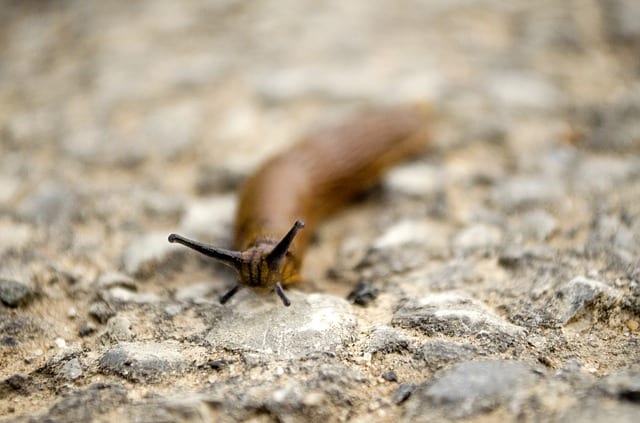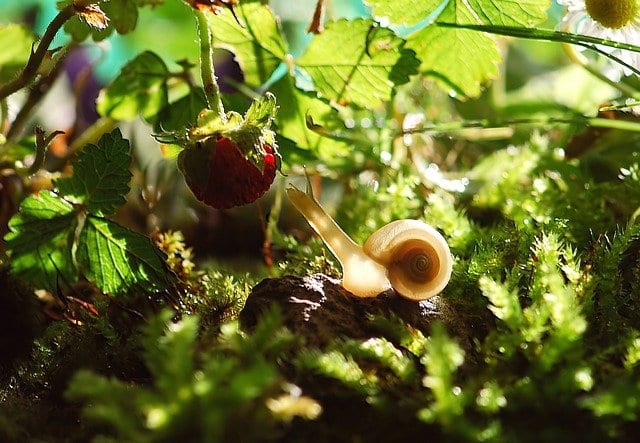Weather has a big impact on what pest issues you may experience in your landscape. Extended periods of rain for instance, can bring out the snails and slugs at levels some may consider apocalyptic; hosta lovers, am I right? On the other hand, when the skies dry up and the sunshine goes from warm and friendly to menacingly hot, spider mites could move in to suck life right out of your beautiful plants; juniper lovers, am I right? We can’t control Mother Nature, so we’ll have to realize that weather is always going to be a factor in the success or failure of our gardening efforts. Sometimes we can control the damage, and sometimes we can’t. (We sure found that out this past winter didn’t we?)
We’ve always advised that when it comes to pest control, early detection is key, and we are sticking to our guns on this one. If you know what you are looking for and when to expect it, it is much easier to prevent the problem and curtail it before it gets overwhelming. We are starting a series on weather and pests this summer, so welcome to the first blog. Today we’re talking about those rain-loving, slime-trailing pests that can coax a blood-curdling scream out of a barefooted gardener: slugs and snails.

Why Rain Attracts Snails and Slugs
Rainy days and wet soil bring the slugs and snails. Rain also spurs on fresh, young, plant growth, which is a delicacy for these pests. Extended periods of rain make it a reason for these pests to celebrate. Cloudy days don’t help dry out the rain so the party keeps going!
Snails and slugs drink through their mouths but also absorb moisture through their bodies. They need plenty of moisture to keep them from drying out. Besides being nocturnal, this is why they generally feed under the cover of night, when it is cooler. After the rains, it may feel like these pests have come out of nowhere, but they’ve been there all along. Sunshine and hot weather can suck the moisture right out of their bodies, which is why they hide under pots, rocks, and piles of brush. They need a lot of moisture to produce enough mucous to be able to scoot around on their slimy feet. These pests will wait it out, knowing they have a great food source nearby (a.k.a. your beautiful garden). When the rain arrives, slugs and snails throw caution to the wind and come out to party. What’s a party without some great food?

Preventing and Controlling Snails and Slugs
1. Avoid planting plants that snails and slugs prefer. You can attempt to prevent slug and snail damage by not choosing the types of plants they tend to like best; plants that have a higher water and/or nutrient content than some others. These include, but definitely are not limited to: hostas, cast iron plant, succulents, veggies (plants and fruits), strawberries, basil, petunias, zinnia, larkspur, etc… Certain fragrant plants may act as a deterrent to snails and slugs.
You could try planting garlic, chives, rosemary, and lavender among your favorite plants if they tend to attract these pests. (Make sure all plants you are companion planting have the same light and watering requirements.)
2. Physically protect plants from slugs and snails when they are most vulnerable. When leafy vegetables and plants are in their young stages, fresh and green, and ready to take on the world, snails and slugs are most enticed. You can use physical barriers such as copper tape (best for pots, placed just below the top rim), and garden cloches that can physically prevent slugs and snails from reaching them. However, this can get expensive if you have a ton of plants to protect. You can cut down on the cost of garden cloches if you make your own; upcycle large, transparent, plastic cups for snail and slug use. Cut the bottoms off (the raggedy and sharper the edges the better) and place over young, tender growth for protection.
Other means of physical slug and snail barriers are sprinkling crushed eggshells, crushed seashells, or other sharp and rough material around the plants. Picture how it would feel to have to walk across Legos® to get your food everyday. Ouch, right? Well snails and slugs don’t like it either.
Diatomaceous Earth acts like shards of glass on the underbellies of pests. Sprinkling this on the soil around plants is another good barrier type of protection against slugs and snails, but will need to be reapplied as long as rain stays around.
3. Beer traps. Beer traps can be an effective form of slug and snail controls but are not for the squeamish because you’ll have to empty them out at some point! Ewww!
How to: Choose a darker beer (I know, waste of good beer!), open it and let it sit out for a couple of days so it ferments a little and is more enticing to the snails and slugs. Pour it into a container like and old butter tub and place the container by the base of your plants. Snails and slugs can’t resist the beer party, but also can’t find a way out of it. Instructions for all of these DIY control methods can be found on the web.
4. Using slug and snail baits is one of the easiest and most effective ways to help eradicate these pests. Sprinkle the baits on the soil around the base of your plants and the slugs and snails eat the pellets and end up with more than a stomachache if you know what I mean. Baits and pellets need to be replenished around every 4 weeks while you have the problem, or possibly sooner during periods of heavy rain.
Hot weather is heading in fast, and before you know it, we will need to talk about the control of pests that arrive in summer. Guess who will be bringing you that next week? That’s right, it’s us! See you then.
~The Happy Gardener, Lisa Mulroy


Need to get rid of cottle bugs the ones that role up in ball
Hi Kenny,
We recommend the product Sluggo Plus to eradicate pillbugs/cottlebugs/sowbugs. This has been very effective. Read label and apply and reapply as directed. Hope this helps!
great slug (ewwww) infor. Thanks a bunch! My new hollyhock seedlings attracted the little buggers the minute they were transplanted from their pots to the real dirt. grrrrr. Thanks again.
I agree…ewwwwww. You’re very welcome. Thank you for taking the time to read.